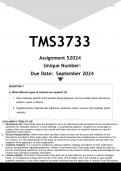TMS3733
Assignment 52024
Unique Number:
Due Date: September 2024
QUESTION 1
a. What different types of material are needed? (2)
1. Raw materials specific to the product being designed, such as metals (steel, aluminum),
plastics, wood, or fabrics.
2. Supplementary materials like adhesives, fasteners (nails, screws), and coatings (paint,
varnish).
b. What should the quality of the different materials be? (2)
DISCLAIMER & TERMS OF USE
1. Educational Aid: These study notes are designed to serve as educational aids and should not be considered as a
substitute for individual research, critical thinking, or professional guidance. Students are encouraged to
conduct their own extensive research and consult with their instructors or academic advisors for specific
assignment requirements.
2. Personal Responsibility: While every effort has been made to ensure the accuracy and reliability of the
information provided in these study notes, the seller cannot guarantee the completeness or correctness of all
the content. It is the responsibility of the buyer to verify the accuracy of the information and use their own
judgment when applying it to their assignments.
3. Academic Integrity: It is crucial for students to uphold academic integrity and adhere to their institution's
policies and guidelines regarding plagiarism, citation, and referencing. These study notes should be used as a
tool for learning and inspiration, but any direct reproduction of the content without proper acknowledgment and
citation may constitute academic misconduct.
4. Limited Liability: The seller of these study notes shall not be held liable for any direct or indirect damages,
losses, or consequences arising from the use of the notes. This includes, but is not limited to, poor grades,
academic penalties, or any other negative outcomes resulting from the application or misuse of the information
prov
]
, For additional support +27 81 278 3372
QUESTION 1
a. What different types of material are needed? (2)
1. Raw materials specific to the product being designed, such as metals (steel,
aluminum), plastics, wood, or fabrics.
2. Supplementary materials like adhesives, fasteners (nails, screws), and coatings
(paint, varnish).
b. What should the quality of the different materials be? (2)
1. The materials should be durable and appropriate for the product's intended use, such
as high tensile strength for metals or flexibility for certain plastics.
2. The materials must meet industry standards and specifications to ensure safety and
performance.
c. What are the sizes of the available raw materials? (3)
1. Standard sheet sizes for materials like metal or wood (e.g., 4x8 feet for plywood).
2. Rod or bar lengths for metals, often available in sizes like 6 feet or 12 feet.
3. Rolls or lengths for fabrics or plastics, typically available in specific widths (e.g., 1-
meter width).
d. Will the different materials have to be cut to size? (5)
1. Yes, many raw materials will likely need to be cut to fit the specific dimensions of the
product.
2. Sheets of metal or wood may need to be trimmed to create parts.
3. Rods and bars will require cutting to appropriate lengths for assembly.
4. Fabrics and plastics may need to be measured and cut based on design
specifications.
5. Precise cutting techniques, such as laser cutting or saws, may be required depending
on the material.
e. Will the different materials have to be shaped? (5)
1. Yes, certain materials will need to be shaped to meet design requirements.




